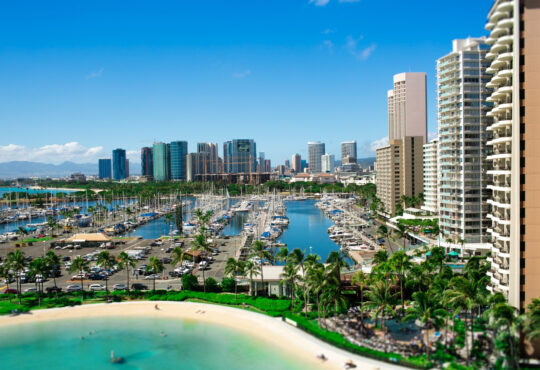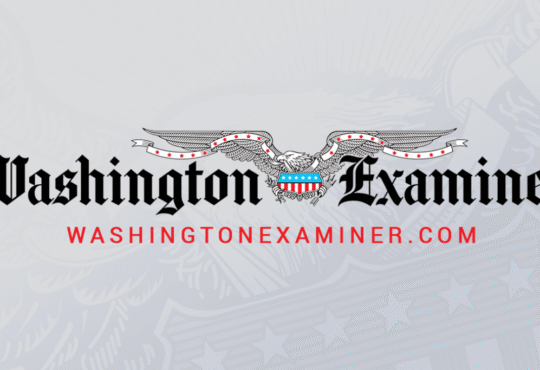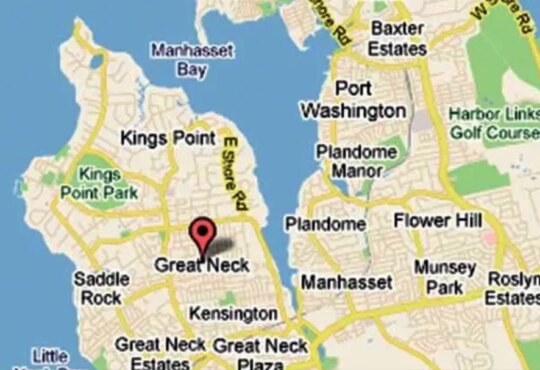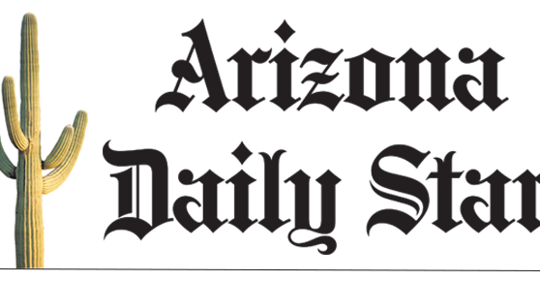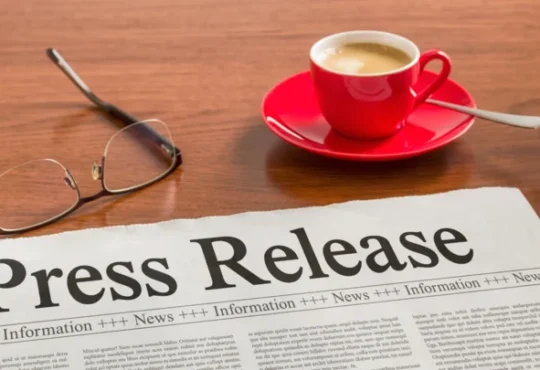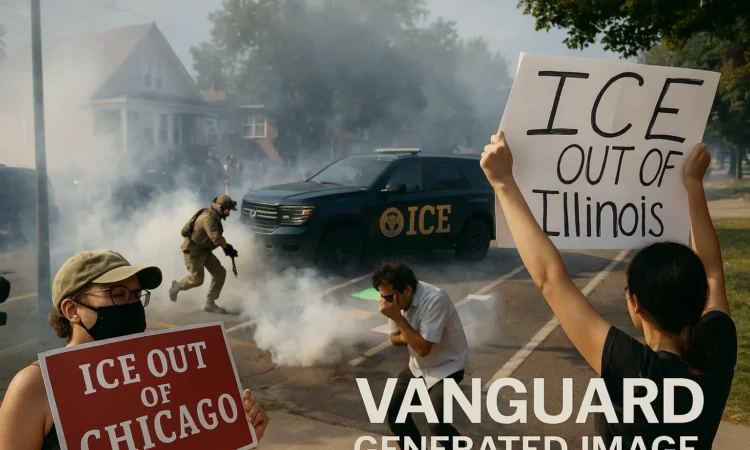
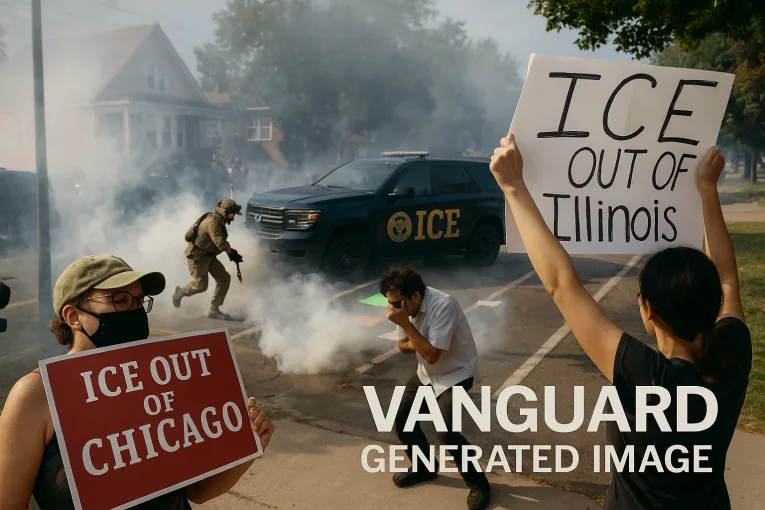
- Federal agents in Chicago used excessive force against civilians, including tear gas and pepper rounds.
- Masked federal personnel patrolled city streets, stopping people and cloaking immigration enforcement as wartime.
- Local officers were left to manage the fallout from federal actions.
What does it look like when a democracy begins to acclimate to tactics it once considered unthinkable?
In Chicago this week, we saw federal agents ram a civilian vehicle on a residential street, deploy tear gas and pepper rounds in a neighborhood with children and seniors, and leave even local officers coughing and stumbling as they tried to de-escalate the chaos.
We saw masked federal personnel patrolling city streets, stopping people on sidewalks, and cloaking routine immigration enforcement in the aesthetics and posture of wartime.
We saw neighbors organize watch groups, blow whistles, and flood Signal threads because they do not recognize what is happening in their own communities.
Officials have dubbed the latest push “Operation Midway Blitz,” a campaign built on the theory that mass interior enforcement must be fast, overwhelming, and public—less to catch individuals than to demonstrate that the government can arrest people spectacularly, unpredictably, and with a force that intimidates an entire population.
The theater is the point: spectacle builds power.
The justifications arrive in familiar form. Federal agencies say suspects rammed an agent’s vehicle, crowds turned hostile, and officers responded with “crowd control measures.” They say the priority is “the worst of the worst.” They say critics are ignoring the risks to law enforcement. They always say the ends demand the means.
But in case after case, the facts do not line up with the rationale.
The government’s own numbers, released to trumpet arrests, often include only scant details about criminal histories that would justify extraordinary tactics.
The bulk of the dragnet captures people with little or no serious record – and often people who are in fact US citizens. Meanwhile, footage and eyewitness accounts keep showing agents escalating encounters in ways that would get local police departments sued, sanctioned, or both.
The first tell of a police-state pretense is the gap between narrative and reality—when words lose their moorings in facts, power becomes the anchor, and once the state calls a neighborhood a battlefield, the cameras supply the smoke.
The second tell is the normalization of exceptional force as routine—high-risk vehicle immobilization techniques meant for last-resort emergencies are deployed on busy residential streets, and chemical agents designed for controlled riot response are used in ad hoc dispersals that leave babies, teenagers, and bystanders choking on the curb.
Masking may be justified to protect undercover identities in limited contexts, but when public-facing operations become a procession of faceless enforcers, the practice—along with other “situational” defenses—establishes a new baseline where militarized methods are the norm and restraint the anomaly.
The third tell is the blurring of jurisdictional accountability—Border Patrol operating in city streets, ICE agents carrying long guns on commuter strips, the Federal Protective Service drifting from courthouse perimeters into neighborhood sweeps, and local departments first summoned to assist, then sidelined, then caught in the wash of chemical agents.
In this fog, it becomes harder to know who authorized what and under which rules of engagement, easier to evade sunlight and blur responsibility, and easiest of all to dismiss criticism as confusion—don’t blame us, it was another federal unit; don’t blame them, it was a joint operation; don’t blame anyone, the crowd was unruly.
The fourth tell is the redefinition of dissent as threat. A crowd that gathers to film becomes an unruly mob. A mother who shouts that her son is a citizen becomes an agitator. A pastor praying outside a facility becomes a provocateur. Journalists become obstacles. The cameras become targets.
When officers treat documentation itself as a trigger for force, they invert the premise of public oversight. The recording of public operations in public spaces is not a disruption; it is the safety valve of a free society.
If the presence of witnesses is framed as escalation, the only acceptable public is a quiet one.
The fifth tell is the insistence that quantity equals success. The headline number—hundreds or thousands detained—becomes the metric, no matter who those people are or what they have done. The administration highlights a few serious cases to justify the rest and relies on spectacle to bury the details.
Years of research show that immigrants, including undocumented immigrants, commit crimes at lower rates than native-born Americans and that increases in undocumented populations do not drive violent crime.
When interior enforcement primarily captures workers, parents, and longtime residents with U.S.-citizen family members, the claim that mass sweeps are about public safety collapses. The policy itself is the point. The targets are the message.
All of this lands hardest on communities already over-policed and under-protected. Residents of Chicago’s Southeast and South Sides do not need a lesson in the long American history of state power bearing down on people of color—they live it daily.
They know that when force is unleashed without discipline, the harm is not borne equally. The fear is not theoretical; it is embodied and immediate.
It is the body pinned to the asphalt, the teenager cuffed and loaded into an unmarked SUV, the neighbor who never returns from a coffee run, the child who learns to associate sirens with smoke.
There is a temptation in moments like this to shrug and say that immigration enforcement is always messy, that the border has simply moved inland, that the law is the law. That temptation is a luxury.
Laws are not self-executing; they are carried out by people who make deliberate choices about priorities, resources, and proportionality. The decision to abandon “worst first” targeting in favor of high-volume sweeps was a choice. The decision to send masked agents into densely populated neighborhoods was a choice.
The decision to normalize ramming, gassing, and pepper-balling blocks where families shop and walk to school was a choice. Each choice carries moral and constitutional consequences.
The long-term costs are larger than any one operation. Trust in law enforcement erodes, and with it the willingness of victims and witnesses to cooperate.
Local officers are left to manage the fallout from federal actions they neither directed nor controlled, straining both budgets and relationships. Civil litigation will drain public dollars away from genuine public safety efforts.
The next generation grows up believing that the government shows up to hurt, not to help. When we treat these outcomes as collateral damage, we are telling communities that their consent is not required—and that lesson, once learned, is hard to reverse.
There is another cost: the corrosion of our language about freedom. Words like “rule of law” and “public safety” are precious because they carry the weight of a shared promise.
They do not mean “whatever the state can get away with.” They do not mean “maximum arrests at minimum scrutiny.” They do not mean “mask up and move fast.”
They mean impartiality, transparency, proportionality, and fidelity to the rights of the governed. If we use them to launder force, we will wake up one day to find those words empty and those promises gone.
We do not have to accept this trajectory. Governors and mayors can insist on memorandums of understanding that define roles, limit tactics, and require identification and filming rules for federal personnel operating on city streets.
Local departments can refuse to serve as props in federal theater and set conditions for mutual aid that protect both their residents and their officers. State attorneys general can investigate and, when warranted, prosecute excessive force and unlawful detentions. Courts can and should enforce the First and Fourth Amendments without deference to uniforms or acronyms.
City councils can fund legal defense networks, know-your-rights campaigns, and rapid-response hotlines so panic does not feed on rumor. Journalists can keep their cameras rolling and their heads clear.
Most importantly, the public can demand that immigration enforcement return to sane priorities—focusing on genuine threats to safety rather than parents walking to work or teenagers leaving a pharmacy, recognizing that public safety cannot be pursued through public harm, and refusing to let “illegal” become a spell that suspends the Constitution.
A democratic society is judged by how it wields force against the least powerful, and when the government can tear-gas a neighborhood because cameras make an arrest inconvenient or flood city streets with masked agents accountable to no local authority, the line between consent and coercion—and with it, self-government itself—begins to disappear.
The pretense of an emerging police state is not that the state suddenly becomes omnipotent, but that ordinary people begin to doubt their own power—growing accustomed to the smoke, averting their eyes as the caravans roll by, and ceasing to believe that the words etched into marble buildings will protect them.
The antidote is not despair; it is resistance—the resistance to euphemism and silence, to the slow normalization of cruelty, and to the erosion of rights through fear. It is the resistance to accept the abuse of power as routine, to defend the dignity and safety of people we do not know, and to demand equal protection for those who may not yet have full papers. It is the resistance of a republic that remembers who the government is supposed to serve.
We have seen enough this month to know which path we are on.
Follow the Vanguard on Social Media – X, Instagram and Facebook. Subscribe the Vanguard News letters. To make a tax-deductible donation, please visit davisvanguard.org/donate or give directly through ActBlue. Your support will ensure that the vital work of the Vanguard continues.
Categories:
Breaking News Immigration National Issues Opinion
Tags:
Authoritarianism Chicago protests Civil Liberties community resistance Federal Agents federal overreach ICE agents ICE Raids immigration enforcement Neighborhood sweeps Operation Midway Blitz Police Militarization Trump Administration

